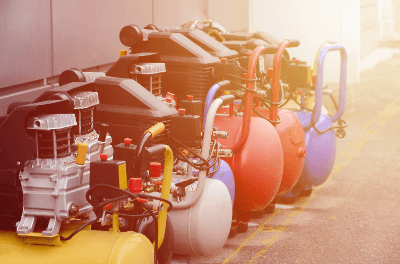What Is a Compressor Engine?
 As the name suggests, a compressor engine is a type of compressor that is operated by an engine rather than an electric system.
As the name suggests, a compressor engine is a type of compressor that is operated by an engine rather than an electric system.
The compressor is needed to produce compressed air to operate tools and machines. The most important feature of a compressor engine is that it does not require a power source, so air tools can be used in any location.
This is a powerful feature for outdoor work, where it is difficult to secure a power source. Many are designed to be compact, and most are equipped with wheels. They can work in any location and are easy to move and transport, providing excellent mobility.
Uses of Compressor Engines
Compressor engines are often used for outdoor work in situations where it is difficult to secure a power source. Construction work, painting work, and business trips are difficult to secure a power source, and air tools are used in all kinds of locations while the compressor is being transported.
With a compressor engine, there is no need to secure a power source, and it is easy to transport because it is equipped with wheels. Although the highly mobile engine type is widely used, the motor type is used in factories.
Principle of Compressor Engines
A compressor engine consists of three mechanisms: compression, discharge, and suction.
1. Compression
The motor drives the piston up, compressing the air in the compressor. This increases the pressure inside the compressor and the air becomes energized. Compressor oil is injected to cool the heat generated during the compression process and to prevent air leaks.
2. Discharge
The discharge valve is released when the piston reaches its highest point. At this time, the high-pressure air inside the cylinder is discharged. The discharged air becomes the power source for the machine and tools. At this time, the oil is transferred to the oil cooler for cooling.
3. Suction
After completion of the discharge, the piston moves down and the discharge valve closes. When the pressure inside the compressor drops, the intake valve opens, and the required amount of air is sucked in.
How to Choose a Compressor Engines
Select an engine compressor by focusing on the air volume and pressure, and whether it has an after-cooler or not.
1. Air Volume
This refers to the amount of compressed air discharged by the compressor per unit of time. The units used are L/min, m3/min, etc.
When selecting a compressor engine, please allow a margin of about 20% of the air volume required in the catalog for each tool. For example, a rock drill requires an air volume of 1.5~3.5 m3/min. Insufficient air volume will result in loss of control of the tool or machine to be operated.
2. Pressure
This refers to the force that can be applied per unit area of compressed air. Units such as MPa are used. There are two types of pressure indication methods: absolute pressure based on vacuum and gauge pressure based on atmospheric pressure.
The pressure of a compressor engine is expressed in terms of gauge pressure. The discharge pressure of a standard specification compressor is 0.7 MPa. Insufficient pressure as well as air volume will cause loss of control of tools and machine tools.
3. After-Cooler
Air contains water vapor, which condenses into a liquid when compressed by a compressor. The role of the aftercooler is to cool the hot compressed air while removing the condensed water.
The aftercooler prevents water from accumulating in the compressor’s pipe system. It is also used in compressors for painting and other applications to prevent air bubbles from entering the system. Using a compressor without an aftercooler can lead to problems such as freezing and not running, or water splashing out and contaminating the system.
Types of Compressor Engines
1. Screw Type
Male and female screw rotors are housed in a container called a casing. The screw type compresses air by rotating the screw rotor inside the casing. The screw type can be further classified into two types: oil-cooled and oil-free.
The oil-free type does not require oil injection because the screws do not make contact with each other where they engage. Therefore, the oil-free type can output air with less oil content. The oil-cooled type compresses air while injecting oil into the screw rotor. It is generally used for industrial applications.
2. Scroll Type
The scroll type compressor has a structure in which air is compressed by a spiral-shaped compression section. This type is used in compressors that require small capacity and low noise. It consists of parts called a fixed scroll and a movable scroll. Air is sucked in and compressed by changing the volume of the space separated by these two parts.